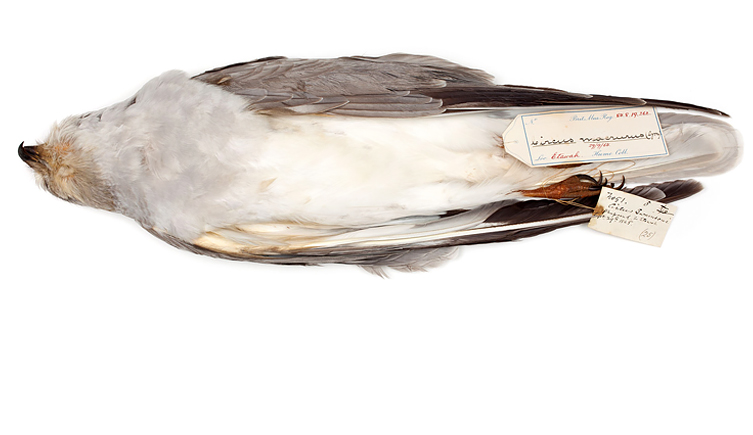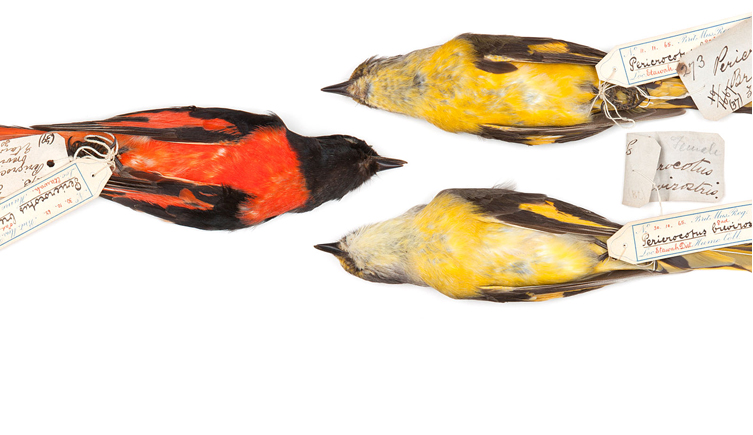
Type specimen of large-billed reed warbler, Acrocephalus orinus, collected by Hume in 1867 and only rediscovered in the wild in Thailand in 2006.
The largest single collection of birds ever received by the Museum was given by Allan Octavian Hume in 1885. The collection contains more than 60,000 bird skins and nearly 20,000 eggs from the Indian sub-continent.
Skins
60,000
Eggs
20,000
The largest single collection of birds ever received by the Museum was the over 80,000 specimens (including more than 60,000 skins and approaching 20,000 eggs) received from Allan Octavian Hume in 1885. These represent the physical results of research into the birds of the Indian sub-continent that Hume had either undertaken himself, or co-ordinated others to do, over the preceding 20 years.
During this time he had produced about 200 ornithological publications, including a number of major monographs, described at least 148 new bird taxa that are still accepted today, and founded and single-handedly edited the journal Stray Feathers, which itself ran to over 5,000 pages.
In the early 1880s, Hume’s life underwent a succession of major upheavals, including his early retirement after his enlightened egalitarian attitudes towards the Indian populace fell foul of his superiors, a flirtation with Theosophy during which he converted to vegetarianism, and most tragically the loss through theft of most of his manuscript material for his planned magnum opus on 'Birds of the British Indian Empire', which would have covered the whole sub-continent (a far wider region than modern India).
It was the loss of the manuscript that precipitated his decision to donate his bird collection to the Natural History Museum and effectively give up ornithology. Remaining in India until the early 1890s, Hume played a key role in the founding of the Indian National Congress, the party that has governed India for much of the time since independence in 1947.
Returning to Britain thereafter and settling in south London, Hume took up British botany with the same enthusiasm and ability that he had formerly devoted to Indian ornithology, and shortly before his death founded and endowed the South London Botanical Institute, an organisation for ordinary working people keen to contribute to the science and still flourishing over one hundred years later.
-

Specimen of pallid harrier, Circus macrourus, collected by Hume in 1865 and mentioned in his diaries.
-

Pericrocotus brevirostris
Hume's diaries
Hume’s bird collection, now held by the Natural History Museum, remains unparalleled in its scope and has for the past 125 years continued to provide an essential core resource for all research into avian taxonomy and distribution relating to the Indian sub-continent.
Few of Hume’s diaries or unpublished papers relating to ornithology have survived, but the Museum does hold nine of his diaries covering small segments of the period from 1859 to 1881, which essentially spans his serious involvement in ornithology. Only one of these has to date been published, but all are currently being transcribed with the intention of making their contents available.
Looking for a specimen?
The bird collection is being digitised
Senior curator
Mark Adams
Curator
Hein Van Grouw
Any questions?
If you would like to use any specimens for research, please get in touch
Related information

Collections on the move
Access to some collections will be affected as we prepare for the move to our new collections, science and digitisation centre.

Accessing the collections
Scientists and collections management specialists can visit the collections and borrow specimens for research.

Collections management
Our duty is to provide a safe and secure environment for all of our collections.